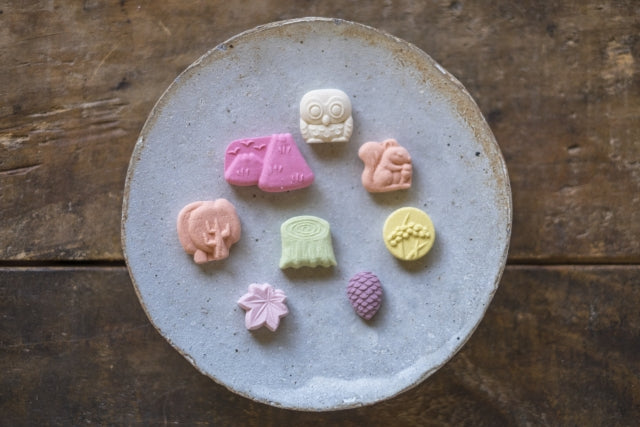湯呑みに関する私の記事は主にお茶に関するものばかりなので、今回は少し趣向を変えて、「和三盆」と呼ばれる伝統的で特別な砂糖について書いてみようと思います。和三盆糖は、竹糖(通称:細粟)と呼ばれる在来種の砂糖から作られます。この在来種は、四国地方の徳島県と香川県の地域で今も栽培されています。和三盆糖は、機械を使わずに作られる数少ない国産砂糖の一つです。
和三盆の由来
「和三盆」という名前は、特に日本語が母国語でない人にとっては、長い名前です。元々は三盆糖( 漢字の最後に砂糖が付く)と呼ばれていましたが、なぜ「和三盆」になったのかは曖昧で、いくつかの説があるようです。一説によると、「三盆」は香川県の三本松がこの砂糖の積出港だったことに由来するという説もありますが、おそらく最も有力な説は、この砂糖を精製するために、「盆」と呼ばれる盆の上で砂糖を3回削る(つまり、「削る」とは砂糖の粒子を細かくする行為を指す)ことから来ているのでしょう。この精製技術が広まるにつれて、三本砂糖の生産が始まり、最初は専用の削り台がなかったため、人々は単に手元にある盆(日本語で「盆」と呼ばれる)の上で削っていたと言われています。また、この時代は白砂糖がなかった時代です。そのため、砂糖を三度挽いた和三盆は精製された砂糖とみなされ、出荷可能な完成品とされていたようです。「和菓子」と同様に、和三盆の「和」は日本を表しています。ちなみに、和三盆が登場する以前は、日本で一番甘い食べ物は柿だったと言われています。
阿波和三盆
時々、「阿波和三盆」と呼ばれる和三盆を見かけることがあります。これは、阿讃山脈の南斜面(徳島県)で生産される砂糖のことを指し、「阿波の国」とも呼ばれています。特に、阿波和三盆は徳島県北部、板野郡上板町で生産されています( ※香川県産の砂糖は讃岐和三盆と呼ばれます)。
阿波和三盆の産地は、阿讃山脈から南に伸びる扇状地に位置しているため、日当たりは良いものの水はけが悪く、江戸時代には灌漑用水のない田んぼの管理が難しく、稲作の難しい地域でした。伝説によると、旅の僧侶が立ち寄った際、九州で同様の土壌でサトウキビが栽培されていると伝えたところ、それを聞いた一人が丸山という若者でした。彼は単身日向国(九州南東部、現在の宮崎県に相当) へ渡り、サトウキビの苗と製法を持ち帰り、この地におけるサトウキビ栽培の基礎を築いたと言われています。
歴史的背景をより一般的に説明すると、この地域でサトウキビが栽培されるようになったのは200年以上も前のことと言われています。日本でサトウキビ栽培が始まったのは、徳川吉宗が砂糖の生産と産業を奨励したからです。和三盆糖の原料となる「竹糖(ちくとう)」は、当時からこの地域に適応した在来種と考えられています。当初、戦前には国産砂糖として大量に生産され、徳島県では藍と並ぶ産品となりました。しかし、戦後、台湾などから安価な精製砂糖が輸入されるようになったことで、庶民向けの砂糖としての役割が薄れ、生産者数が減少し、栽培面積も減少しました。
現在では、その独特の香りと味わいから、主に和菓子用の砂糖として使われています。そのため、和菓子作りに使われることで、品質の悪い地域から和三盆糖は姿を消し、栽培地域は一時増加したものの、最終的には非常に高品質なサトウキビが採れる地域だけが残ったと言えるでしょう。とはいえ、日本茶をよく飲む方であれば、和三盆糖をすでにご存知かもしれません。これは、2013年に和食がユネスコの世界無形文化遺産に登録されて以来、和菓子への関心が高まっていることが一因です。さらに、和菓子は味だけでなく見た目も美しく、日本茶とよく合うことから、江戸時代(1603-1868)からお茶と一緒に供されてきました。
 今日のように白砂糖が広く流通していなかった江戸時代、和三盆の控えめな甘さとほのかな香りは、和菓子に繊細な風味を与えていました。今日でも、この組み合わせは続いています!上の写真は、東京の一保堂で和菓子と一緒に出された濃茶(濃い抹茶)です。
今日のように白砂糖が広く流通していなかった江戸時代、和三盆の控えめな甘さとほのかな香りは、和菓子に繊細な風味を与えていました。今日でも、この組み合わせは続いています!上の写真は、東京の一保堂で和菓子と一緒に出された濃茶(濃い抹茶)です。
現在でも、阿波和三盆は徳島県板野郡上板町と隣接する土成町で栽培・製造されています。近年の食の嗜好(しこう)における高品質志向の高まりを受け、和三盆は高級食材として百貨店などでも見られるほど知名度が上がっています。一方で、日本の農業全般の動向と同様に、農業従事者の高齢化や農家数の減少により、今後和三盆の栽培は減少していく可能性が高いのも事実です。
和三盆糖は普通の砂糖とどう違うのでしょうか?
和三盆糖が一般的な砂糖と大きく異なる理由の一つは、その原料にあります。和三盆糖の原料は、家庭で使う砂糖(上白糖やグラニュー糖など)と同じサトウキビです。これらの砂糖はどれもよく似ていますが、和三盆糖の決定的な違いは「竹糖」と呼ばれる品種にあります。この品種は、沖縄県(日本)、台湾、キューバで栽培されている品種と比べて大きく異なり、比較的背丈が低く、非常に細いのが特徴です。完全に成長すると、竹糖は高さ約2メートル(最上部の葉を含む)、太さは大人の人差し指ほどしかありません。背丈も太さも低いため、単位面積あたりの収穫量を考えると、明らかに不利なサイズです。それでも、サトウキビの素朴な味が、このサトウキビが今でも栽培されている理由です。
この竹頭品種のもう一つの特徴は、栽培方法にあります。サトウキビといえば夏の収穫期を思い浮かべるかもしれませんが、竹頭品種では収穫期は12月で、成熟したサトウキビを根ごと収穫します。サトウキビの節には小さな芽が付いているため、収穫したサトウキビの一部は残されます。その後、節を適切な長さに切り、4月に植え付けます。以下は、サトウキビ農家の年間サイクルです。
4月上旬:種キビ(節)を掘り出す
4月上旬:植え付け
数回の除草と水やり
11月中旬:翌年の種子(ジョイント)を植える
11月下旬から12月にかけて収穫
12月:製糖工場がサトウキビの受け入れを開始
和三盆作りの技術を体験
和三盆の繊細な風味は、型に砂糖を流し込んで作る干菓子に最もよく表れます。優美な形をした和三盆菓子は、抹茶と合わせて伝統的な儀式や喫茶店でよく食べられますが、日本では喫茶店やデパートでも購入できます(ただし、市販の干菓子には、輸送中などの腐敗を防ぐため、他の材料が含まれている場合があります)。日本では、徳島県や香川県の製糖工場を訪れ、製糖工場のそばにあるサトウキビ畑を実際に見ることで、伝統的な和三盆菓子作りを体験できます(例えば、徳島県阿波市の服部製糖工場を訪れた 記事をご覧ください)。また、東京でも数時間程度の和菓子作り体験をすることができます。最後に、海外では丁寧に成形された美しい形の和三盆菓子に出会うことは稀かもしれませんが、Yunomiでは、 8代にわたり伝統的なサトウキビを作り続けている三谷製糖の和三盆糖を取り扱っています。お茶に砂糖を入れるのが好きな方や、お菓子作りが好きな方には、この和三盆糖は特に日本茶によく合うかもしれません!さらに、和三盆糖の製造元によると、和三盆糖の魅力はお茶だけにとどまらず、コーヒー、お酒、料理、お菓子作りなどにも幅広く使えるそうです。
 三谷製糖の繊細で美味しい和三盆:和三盆の製造工程の画像やインタビュー動画(日本語)をご覧いただけます。
三谷製糖の繊細で美味しい和三盆:和三盆の製造工程の画像やインタビュー動画(日本語)をご覧いただけます。
関連レシピ:
- 抹茶和三盆シロップ入りクリスタルゼリー
- 冷たい抹茶和三盆ミルクに砕いたコーヒーゼリー(これは暖かい季節にぴったりかも!)
注目の画像: photoAC のcheetahによる和三盆糖。



